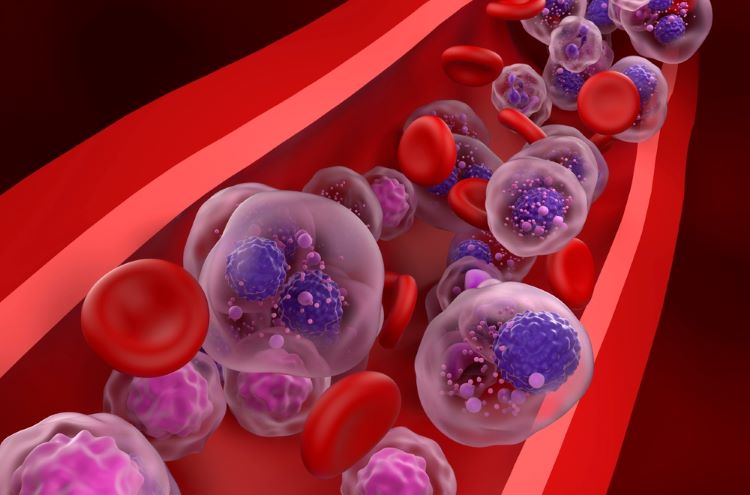Edmond Chan, Senior Director, EMEA Therapeutic Area Lead, Haemato-Oncology, Johnson & Johnson Innovative Medicines, offers insight into the promising evidence of cell therapies and biologic-based treatments for patients with multiple myeloma.


In recent years, several key treatments for multiple myeloma have shown potential to address challenges in the field, such as improving key endpoints like patient survival and response rates and enhancing manufacturing. Speaking to EPR, Edmond Chan, Senior Director, EMEA Therapeutic Area Lead, Haemato-Oncology at Johnson & Johnson Innovative Medicines, highlights recent developments for the CAR-T cell therapy CARVYKTI (ciltacabtagene-autoleucel-cilta-cel), as well the biologics DARZALEX® (daratumumab), TECVAYLI®▼ (teclistamab) and talquetamab and their overall promise as combination therapies.
Additionally, he shares his predictions for the therapy landscape in five years and why applying a targeted treatment approach is important for the field to progress.
Potential of cell therapies and biologics for multiple myeloma
Clinical data1 has shown that the targeted therapy cilta-cel is “highly effective”, according to Chan. For example, the response rate and overall survival trend seen in CARTITUDE-4 study were “unmatched”.
He explained that patients who received the one-off therapy “survived a lot longer compared to those who received the control therapy, pomalidomide, bortezomib and dexamethasone (PVd)”.
Chan stated that data presented at the 2024 American Society of Clinical Oncology (ASCO) Annual Meeting for the biologic TECVAYLI®▼ (teclistamab)2 provide the latest long term follow up for the pivotal Phase I/II MajesTEC-1 study.
For example, in a recent press release,2 Dr Niels van de Donk, Professor of Hematology at Amsterdam University Medical Centers, and principal study investigator, commented that “with the longest follow-up of any bispecific antibody, teclistamab demonstrates continued deep and durable responses observed in patients with relapsed or refractory multiple myeloma who have limited treatment options”.
On the other hand, another biologic, TALVEY (talquetamab), targets the G protein-coupled receptor 5D (GPRC5D) receptor and “works quite differently to the BCMA target like teclistamab or CAR T; it also binds to the cancer cells and bring it to the cell and destroys it”, Chan added.
For transplant-ineligible patients, the Phase III MAIA study4 demonstrated that daratumumab added to lenalidomide and dexamethasone (D-Rd) provided “a median overall survival of about seven years in first line.” This contrasts with 20 years ago where patients were expected to have survival, according to Chan, of “about a year”.
He emphasised that having the first non-transplant study offering a combination therapy that is not as burdensome as a stem cell transplant, “is really exciting”.
Key development challenges for CAR T therapy
Some cell therapies, Chan explained, can be put into storage “and then when a patient needs it, we take it out and give it to the patient”.
However, in the case of CARVYKTI (ciltacabtagene-autoleucel-cilta-cel), the patient is part of the process: a patient’s T cells are modified to recognise the cancer and then infused back into the patient. As this can take time, one key challenge is how to “scale this out… increase our capacity so we can actually provide patient wherever patients need it”.
He highlighted that J&J has a new manufacturing site opening in Ghent, Belgium, which is intended to increase the company’s cilta-cel capacity. It is the first European production facility for CAR-T therapy.5 The second challenge is that supply is “very limited”. It can be “very difficult” to prioritise patients who will be most benefited from this therapy, he noted.
The treatment landscape in five years
Chan went on to discuss regulatory developments within this indication. He stated that in April, the US FDA’s Oncologic Drugs Advisory Committee (ODAC) approved MRD as a surrogate of disease control to aid accelerated approvals of multiple myeloma treatments.
Based on evidence provided in the briefing document for ODAC’s April meeting on this topic, the International Independent Team for Endpoint Approval of Myeloma MRD (I2TEAMM) concluded that “there is sufficient evidence to support use of MRD as an endpoint for accelerated approval, with progression-free survival (PFS) maintained as a long-term endpoint for confirmation of clinical benefit.”
He envisioned that when put into practise, “in five years we will start to see MRD [being used] as a stopping rule” in patients who are MRD negative.
Positively, Chan remarked that this protocol is being applied in the ongoing Phase III PERSEUS study investigating daratumumab (DARA) + bortezomib, lenalidomide, and dexamethasone (D-VRd) compared to Velcade, lenalidomide, and dexamethasone (VRd). In patients who become MRD negative after two years of daratumumab and lenalidomide maintenance therapy, the daratumumab treatment is stopped.
Treatment modalities for multiple myeloma
“We will be seeing a lot of biologic combinations” he continued and predicts there will be “more personalised durational therapy”.
Currently, J&J are investigating a “combination of daratumumab and teclistamab in earlier lines. In theory, these two are actually a very good combination,” Chan explained.
He also shared that the ongoing Phase Ib REDIRECTT-1 study is looking at a combination of the two bispecifics teclistamab and talquetamab. “Two different targets: BCMA [and] GPRC5D, join hands to attack cancer”.
Initial results, presented at the 2023 ASCO Annual Meeting, demonstrated “a very high [overall] response rate [of] about 70 percent”, Chan stated. These are patients with extramedullary disease (EMD), who “not only have the blood disease multiple myeloma but also bone manifestations or deposit elsewhere”.
To compare, he highlighted that traditionally in these patients, “the overall response rate would be around the mid 20s, early 30 percent”.
When considering cell therapy, what is “really, really exciting” in the outlook of targeted therapy.
Currently, in some patients the disease can be put under control, he elucidated. “It’s a lot better than 10 years ago, but we’re still not quite there yet… We are bringing cilta-cel in much earlier line in the frontline therapy. In the future, we hope to see multiple myeloma becoming a curable disease”.
In terms of development in the CAR T space, J&J are “looking into shortening the manufacturing time… and also exploring whether we can produce CAR T that is off the shelf. The space in five years will be very, very different but exciting”.
About the interviewee

 Edmond Chan is Senior Director, EMEA Therapeutic Area Lead, Haemato-Oncology, Johnson & Johnson Innovative Medicines. He joined Janssen in 2012 and has led multiple different functions in the organisation, including R&D, local, regional and global Medical Affairs. As part of his role, he focuses on haematological cancers such as multiple myeloma and chronic lymphocytic leukaemia. He is an experienced, UK-trained pharmaceutical physician, specialising in renal medicine, and holds a doctorate in clinical research in solid organ transplantation.
Edmond Chan is Senior Director, EMEA Therapeutic Area Lead, Haemato-Oncology, Johnson & Johnson Innovative Medicines. He joined Janssen in 2012 and has led multiple different functions in the organisation, including R&D, local, regional and global Medical Affairs. As part of his role, he focuses on haematological cancers such as multiple myeloma and chronic lymphocytic leukaemia. He is an experienced, UK-trained pharmaceutical physician, specialising in renal medicine, and holds a doctorate in clinical research in solid organ transplantation.
References
- CARVYKTI ciltacabtagene autoleucel cilta cel significantly improved progression-free survival and deepened responses versus two standard therapies for patients with functional high-risk multiple myeloma. [Internet] Globe Newswire. 2024. [cited 2024June]. Available from:
https://www.globenewswire.com/news-release/2024/06/03/2892566/0/en/CARVYKTI-ciltacabtagene-autoleucel-cilta-cel-significantly-improved-progression-free-survival-and-deepened-responses-versus-two-standard-therapies-for-patients-with-functional-high.html - TECVAYLI®▼ (teclistamab) shows sustained deep and durable responses in patients with relapsed or refractory multiple myeloma. [Internet] Globe Newswire. 2024. [cited 2024June]. Available from:
https://www.globenewswire.com/news-release/2024/06/03/2892235/0/en/TECVAYLI-teclistamab-shows-sustained-deep-and-durable-responses-in-patients-with-relapsed-or-refractory-multiple-myeloma.html - DARZALEX® (daratumumab)-based regimens significantly improved clinical outcomes in both transplant-eligible and -ineligible patients who are newly diagnosed with multiple myeloma. [Internet] Globe Newswire. 2024. [cited 2024June]. Available from:
https://www.globenewswire.com/news-release/2024/06/03/2892594/0/en/DARZALEX-daratumumab-based-regimens-significantly-improved-clinical-outcomes-in-both-transplant-eligible-and-ineligible-patients-who-are-newly-diagnosed-with-multiple-myeloma.html - Overall Survival Results With Daratumumab, Lenalidomide, And Dexamethasone Versus Lenalidomide And Dexamethasone In Transplant-Ineligible Newly Diagnosed Multiple Myeloma: Phase 3 Maia Study. [Internet] Globe Newswire. 2021. [cited 2024June]. Available from:
https://library.ehaweb.org/eha/2021/eha2021-virtual-congress/330171/thierry.facon.overall.survival.results.with.daratumumab.lenalidomide.and.html?f=menu%3D6%2Abrowseby%3D8%2Asortby%3D2%2Amedia%3D3%2Ace_id%3D2035%2Amarker%3D1284%2Afeatured%3D17286 - Janssen to produce innovative cell therapies in Belgium. [Internet] Globe Newswire. 2024. [cited 2024June]. Available from:
https://www.janssen.com/belgium/janssen-invests-european-production-site-cell-therapy-belgium
- SEO Powered Content & PR Distribution. Get Amplified Today.
- PlatoData.Network Vertical Generative Ai. Empower Yourself. Access Here.
- PlatoAiStream. Web3 Intelligence. Knowledge Amplified. Access Here.
- PlatoESG. Carbon, CleanTech, Energy, Environment, Solar, Waste Management. Access Here.
- PlatoHealth. Biotech and Clinical Trials Intelligence. Access Here.
- Source: https://www.europeanpharmaceuticalreview.com/article/229958/advancing-targeted-treatments-for-multiple-myeloma/
